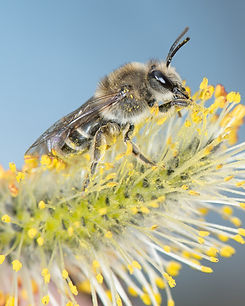
Family Andrenidae > Genus Protandrena
Protandrena
Mining Bees
In Minnesota, there are ten described species within the genus Protandrena. Some species formerly within the genus Pseudopanurgus were recently reclassified and placed in the genus Protandrena. Collectively, the ten species in Minnesota are active from late June until the end of September. Seven species are pollen specialists (oligoleges), and all but one specialize on plant genera in the family Asteraceae. Their pollen host plants include sunflower (Helianthus), goldenrod (Solidago, Euthamia), black-eyed Susan (Rudbeckia), goldenaster (Heterotheca), fleabane (Erigeron), and gumweed (Grindelia) as well as New Jersey tea (Ceanothus) within the family Rhamnaceae.
All species in this genus nest in the ground; in Minnesota, it is likely that all Protandrena have solitary nests. Protandrena are dark, relatively hairless bees with gray-green eyes. Protandrena males have white or yellow facial markings, one characteristic helpful for identification. However, identifying species by photograph or in the field is usually not possible.

A Protandrena female visits Heterotheca villosa.


Wing
position
on flowers
10
no. species
in MN
size range

Phenology

Genus Characteristics

Gray-green eyes; pollen-collecting hairs (scopae) on hind leg tibiae.

Dark gray or black integument with sparse hairs.

3
1
2
Three forewing submarginal cells and a truncate marginal cell. (Photo of Andrena wing)

Male with yellow or white facial markings, broad head, and moderately diverging eyes. Males and females often mate while visiting flowers.
Distribution

Protandrena aestivalis

Protandrena albitarsis

Protandrena andrenoides

Protandrena bancrofti

Protandrena labrosa

Protandrena parva

Protandrena pauper

Protandrena renimaculata

Protandrena rudbeckiae

Protandrena simulans
Protandrena Species in Minnesota
Scientific Name | Likely Lecty | Host Plant(s) |
|---|---|---|
Protandrena aestivalis | oligolectic | Asteraceae (Gibbs 2023); Solidago, Heterotheca, Chrysopsis (Arduser) |
Protandrena albitarsis | oligolectic | Asteraceae: Heliantheae (Gibbs 2023) |
Protandrena andrenoides | oligolectic | Solidago (Arduser) |
Protandrena bancrofti | polylectic | |
Protandrena labrosa | oligolectic | Rudbeckia, Erigeron (Arduser) |
Protandrena parva | polylectic | |
Protandrena pauper | narrow oligolectic | Ceanothus (Arduser) |
Protandrena renimaculata | oligolectic | Grindelia (Gibbs 2023), Asteraceace: unclear (Arduser) |
Protandrena rudbeckiae | narrow oligolectic | Rudbeckia (Gibbs 2023 & Arduser) |
Protandrena simulans | oligolectic | Helianthus, Grindelia (Arduser) |
Lecty/Host Plant Information: Minnesota Department of Natural Resources, Minnesota Bee Species List (August 2023).
https://files.dnr.state.mn.us/eco/mcbs/mn-statewide-bee-list.pdf
Explore More Andrenidae Genera
Explore Bee Families

Apidae
15 genera, 133 species
Bumble bees Bombus
Longhorn bees
Epimelissodes, Eucera, Melissodes
Carpenter bees
Ceratina, Xylocopa
Honey bees Apis
Digger bees Anthophora
Cuckoo bees Brachymelecta, Epeolus, Holcopasites, Nomada, Neolarra, Triepeolus
Squash bees Xenoglossa

2 genera, 39 species
Halictidae
10 genera, 133 species
Metallic green sweat bees
Agapostemon, Augochlora, Augochlorella, Augochloropsis
Large sweat bees
Dieunomia, Nomia
Short-faced bees Dufourea
Sweat bees Halictus
Small sweat bees Lasioglossum
Cuckoo (blood) bees Sphecodes
Megachilidae
14 genera, 86 species
Resin and pebble bees Anthidiellum, Dianthidium, Heriades, Paranthidium
Carder bees Anthidium, Pseudoanthidium
Mock orange bees Chelostoma
Mason bees Osmia, Hoplitis
Leafcutter bees Megachile
Sharp-tailed cuckoo bees Coelioxys
Dark cuckoo bees Stelis

Citations and Further Reading
Droege, S., Shumar, S., & Maffei, C. (2024). The Very Handy Bee Manual (2.0). Zenodo. https://doi.org/10.5281/zenodo.12812755
Gibbs, J., Hanuschuk, E., Miller, R., Dubois, M., Martini, M., Robinson, S., ... & Onuferko, T. M. (2023). A checklist of the bees (Hymenoptera: Apoidea) of Manitoba, Canada. The Canadian Entomologist, 155, e3.
Mitchell, T. B. (1960). Bees of the eastern United States. Technical Bulletin No. 141. North Carolina Agricultural Experiment Station.
Portman, Z. M., Gardner, J., Lane, I. G., Gerjets, N., Petersen, J. D., Ascher, J. S., ... & Cariveau, D. P. (2023). A checklist of the bees (Hymenoptera: Apoidea) of Minnesota. Zootaxa, 5304(1), 1-95.
Wilson, J. S., & Messinger Carril, O. J. (2016). The bees in your backyard: a guide to North America's bees. Princeton University Press.
Page Photography Credits
Heather Holm







